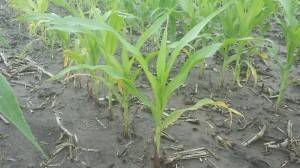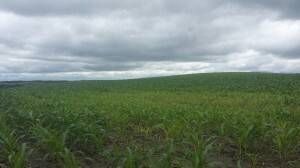 Heavy rain has caused localized ponding and flooding across much of Latham Country. Now farmers are wondering how long corn will survive in saturated soils, what impact of prolonged flooding or ponding will have, and what options they have if crops drowned out.
Heavy rain has caused localized ponding and flooding across much of Latham Country. Now farmers are wondering how long corn will survive in saturated soils, what impact of prolonged flooding or ponding will have, and what options they have if crops drowned out.
Injury level is determined by several factors including: (1) plant stage of development, (2) duration of ponding and (3) air/soil temperatures. Prior to the 6-leaf collar stage or when the growing point is at or below the soil surface, corn can usually survive only 2 to 4 days of flooded conditions. Soybeans can generally handle flooded conditions for 6 to 8 days, research shows.
 Temperatures greater than 77° lessen the amount of time that plants can survive ponds and floods as oxygen levels are depleted more quickly. When oxygen is depleted, roots stop growing and plants stop taking up water.
Temperatures greater than 77° lessen the amount of time that plants can survive ponds and floods as oxygen levels are depleted more quickly. When oxygen is depleted, roots stop growing and plants stop taking up water.
To predict a plant’s ability to survive, check the color of the growing point. The growing point should be white to cream colored; a darkening and/or softening of the growing point usually precedes plant death. Also check the plants about 3 to 5 days after the water drains for new leaf growth.
When ponding or flooding happens early in the growing season – say before June 10 – farmers have the option of replanting corn. Later in the season, farmers still have the option of replanting soybeans. Key soybean replanting dates are:
| Southern Iowa | July 10-12 |
| Central Iowa | July 8-10 |
| Northern Iowa | July 6-8 |
| Southern MN | July 3-4 |
After the first part of July, options are pretty much limited to planting cover crops. Cover crops help prevent essential nutrients like water and nitrogen from running off into rivers and lakes. Cover crops also help control weeds and overcome erosion, which can result when fields are left fallow. Click here for tips on how to determine whether cover crops are right for our situation.
RELATED POSTS:
